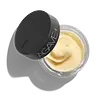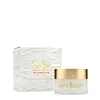What's inside
What's inside
 Key Ingredients
Key Ingredients

 Benefits
Benefits

 Concerns
Concerns

 Ingredients Side-by-side
Ingredients Side-by-side

Ricinus Communis Seed Oil
MaskingTriisostearoyl Polyglyceryl-3 Dimer Dilinoleate
EmollientOleic/Linoleic/Linolenic Polyglycerides
EmollientSqualane
EmollientGlyceryl Rosinate
PerfumingHydrogenated Vegetable Oil
EmollientRhus Verniciflua Peel Cera
EmollientHelianthus Annuus Seed Oil
EmollientPhytosteryl Canola Glycerides
Skin ConditioningCarthamus Tinctorius Seed Oil
MaskingAroma
Simmondsia Chinensis Seed Oil
EmollientPhospholipids
Skin ConditioningPolyglyceryl-3 Diisostearate
EmulsifyingCaprylic/Capric Triglyceride
MaskingTocopherol
AntioxidantPunica Granatum Flower Extract
Skin ConditioningAscorbyl Palmitate
AntioxidantAgave Tequilana Leaf Extract
AstringentMomordica Grosvenorii Fruit Extract
AntioxidantChamomilla Recutita Flower Extract
MaskingTocopheryl Acetate
AntioxidantLimonene
PerfumingLinalool
PerfumingRicinus Communis Seed Oil, Triisostearoyl Polyglyceryl-3 Dimer Dilinoleate, Oleic/Linoleic/Linolenic Polyglycerides, Squalane, Glyceryl Rosinate, Hydrogenated Vegetable Oil, Rhus Verniciflua Peel Cera, Helianthus Annuus Seed Oil, Phytosteryl Canola Glycerides, Carthamus Tinctorius Seed Oil, Aroma, Simmondsia Chinensis Seed Oil, Phospholipids, Polyglyceryl-3 Diisostearate, Caprylic/Capric Triglyceride, Tocopherol, Punica Granatum Flower Extract, Ascorbyl Palmitate, Agave Tequilana Leaf Extract, Momordica Grosvenorii Fruit Extract, Chamomilla Recutita Flower Extract, Tocopheryl Acetate, Limonene, Linalool
Simmondsia Chinensis Seed Oil
EmollientPolybutene
Beeswax
Emulsion StabilisingParaffinum Liquidum
EmollientEthylene/Propylene/Styrene Copolymer
Microcrystalline Wax
Emulsion StabilisingEthylhexyl Palmitate
EmollientPhytosteryl Canola Glycerides
Skin ConditioningPhospholipids
Skin ConditioningPrunus Amygdalus Dulcis Oil
Skin ConditioningPolyhydroxystearic Acid
EmulsifyingButylene/Ethylene/Styrene Copolymer
Caprylic/Capric Triglyceride
MaskingPolyglyceryl-3 Diisostearate
EmulsifyingTocopheryl Acetate
AntioxidantMacadamia Ternifolia Seed Oil
EmollientAroma
Silica
AbrasiveTrihydroxystearin
Skin ConditioningRicinus Communis Seed Oil
MaskingCI 77891
Cosmetic ColorantSaccharin
MaskingSodium Hyaluronate
HumectantAmorphophallus Konjac Root Powder
AbrasiveSimmondsia Chinensis Seed Oil, Polybutene, Beeswax, Paraffinum Liquidum, Ethylene/Propylene/Styrene Copolymer, Microcrystalline Wax, Ethylhexyl Palmitate, Phytosteryl Canola Glycerides, Phospholipids, Prunus Amygdalus Dulcis Oil, Polyhydroxystearic Acid, Butylene/Ethylene/Styrene Copolymer, Caprylic/Capric Triglyceride, Polyglyceryl-3 Diisostearate, Tocopheryl Acetate, Macadamia Ternifolia Seed Oil, Aroma, Silica, Trihydroxystearin, Ricinus Communis Seed Oil, CI 77891, Saccharin, Sodium Hyaluronate, Amorphophallus Konjac Root Powder
Ingredients Explained
These ingredients are found in both products.
Ingredients higher up in an ingredient list are typically present in a larger amount.
Aroma refers to an ingredient, or mixture of ingredients, that impart or mask a flavor.
The name is slightly confusing. This is because INCI associates aroma with flavor instead of smell.
Here is the official definition from the The International Cosmetic Ingredient Dictionary and Handbook:
“Aroma is a term for ingredient labeling used to identify that a product contains a material or combination of materials normally added to a cosmetic to produce or to mask a particular flavor.”
INCI shows the only purpose of aroma to be "flavouring".
However, due to regulation differences, some companies may use aroma in place of parfum.
In Canada, this ingredient only has to be listed in concentrations above 1%.
Learn more about AromaThis ingredient is an emollient, solvent, and texture enhancer. It is considered a skin-softener by helping the skin prevent moisture loss.
It helps thicken a product's formula and makes it easier to spread by dissolving clumping compounds.
Caprylic Triglyceride is made by combining glycerin with coconut oil, forming a clear liquid.
While there is an assumption Caprylic Triglyceride can clog pores due to it being derived from coconut oil, there is no research supporting this.
Learn more about Caprylic/Capric TriglyceridePhospholipids are naturally found in our skin as they are the main component of cell membranes. Phospholipids have humectant, emollient, antioxidant properties.
Phospholipids are complex lipids that contain glycerin, two fatty acids, and a phosphate group. Some foods that contain phospholipids include soybeans and milk. The phospholipids found in soy come from Lecithin. This ingredient can also be synthetically created.
Due to their hygroscopic nature, they act as both humectants and emollients. Humectants draw moisture from the air to your skin, while emollients help trap moisture in.
The phospholipids in our skin can be naturally depleted. Replenishing the phospholipids in our skin can help hydrate your skin.
Studies show phospholipids display antioxidant activity and may help with reducing the signs of aging.
This ingredient is non-occlusive.
Some types of phospholipids:
Learn more about PhospholipidsPhytosteryl Canola Glycerides isn't fungal acne safe.
Polyglyceryl-3 Diisostearate is an emulsifer and emollient. It comes from Isostearic Acid and Polyglycerin-3.
As an emulsifier, it helps stabilize products by preventing oils and water from separating.
This ingredient may not be Malassezia folliculitis, or fungal acne safe.
Learn more about Polyglyceryl-3 DiisostearateRicinus Communis Seed Oil is the INCI name for castor oil.
Castor Oil helps moisturize the skin. It is rich in a fatty acid called ricinoleic acid. This fatty acid helps prevent moisture loss on the skin. This helps keep your skin soft and hydrated. Ricinoleic acid also has anti-inflammatory and pain reducing properties.
Besides hydrating the skin, castor oil is also used to hydrate hair. By keeping the hair shaft moisturized, breakage is decreased. More studies are needed to show castor oil's effective on stimulating hair growth.
Castor oil is created by cold-pressing castor seeds and then purifying the oil with heat. It was used in Ancient Egypt as fuel in lamps and to help treat eye irritation.
The term 'fragrance' is not regulated in many countries. In many cases, it is up to the brand to define this term. For instance, many brands choose to label themselves as "fragrance-free" because they are not using synthetic fragrances. However, their products may still contain ingredients such as essential oils that are considered a fragrance.
Learn more about Ricinus Communis Seed OilThis oil comes from the seeds of the desert shrub called Jojoba. It is more commonly known as jojoba oil, a non-comedogenic oil.
Jojoba oil does not contain fragrance and has many fatty-acids, making it a great soothing ingredient.
It also contains Vitamin E, a great moisturizing ingredient. Vitamin E is also an antioxidant and protects your skin against oxidative damage.
This ingredient humectant properties, meaning it helps draw moisture from the air. This helps keep your skin hydrated.
While jojoba has antibacterial properties, it is only able to kill some strains of bacteria.
Studies also show it helps in wound healing. In fact, Indigenous cultures have used jojoba as a moisturizer and to help treat burns for centuries.
Fun fact: Jojoba oil similar to natural human skin sebum, so it has a great effect on dry skin. It is also promising with helping to regulate sebum production.
Due to its fatty acid content, Jojoba oil may not be fungal acne safe. We recommend speaking with a professional if you have any concerns.
Learn more about Simmondsia Chinensis Seed OilTocopheryl Acetate is AKA Vitamin E. It is an antioxidant and protects your skin from free radicals. Free radicals damage the skin by breaking down collagen.
One study found using Tocopheryl Acetate with Vitamin C decreased the number of sunburned cells.
Tocopheryl Acetate is commonly found in both skincare and dietary supplements.
Learn more about Tocopheryl Acetate